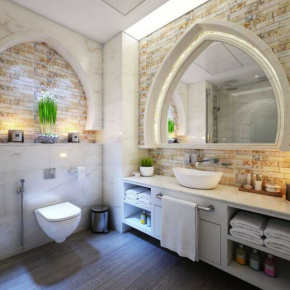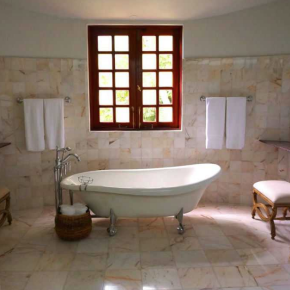
The ultimate underfloor heating guide for your summertime bathroom remodel
The following guest article explores underfloor heating options for bathroom remodels in the summer season.
“IF you are about to complete a bathroom remodel during the summer months, it’s quite likely you may overlook the idea of installing underfloor heating. It’s likely you will find it hard to envisage those cold winter months and what it feels like to step out of the shower onto a freezing cold floor. And if you are pondering this on a particularly balmy day, you may even love the idea of a cold floor!
Just because it’s warm outside it doesn’t mean you should rule out underfloor heating in your renovation plans. Let’s be clear. There really is nothing worse than tip-toeing around a cold tiled floor during the winter.
Underfloor heating in the bathroom is a wonderful luxury during the winter. It’s fabulous to walk on and makes your daily showering and bathing experience a pleasure. And, with the UK’s tendency to inclement weather, underfloor heating can be a blessing all year round.
On a chilly summer morning, underfloor heating is a great way to bring a little warmth to your bathroom and help ease you into the day. No-one wants to put the central heating on during the summer but enjoying the luxury of a warm bathroom floor feels somehow more acceptable.
There are pros and cons when it comes to underfloor heating though, so check out the advantages and disadvantages in our handy guide before you take the plunge and add it to your summertime bathroom renovation plans.
Underfloor heating – facts you need to know
There are two main types of underfloor heating (wet and dry). A wet underfloor heating system uses water to heat the floor, while a dry system uses electricity. Electric underfloor heating systems are the most commonly used system for single-room underfloor heating, such as in the bathroom.
Electric underfloor heating is cheaper and easier to install, but generally has higher running costs than water underfloor heating. Water underfloor heating is a lot more involved and costly to install so is generally considered more in new builds when the system can be factored in at the planning stage.
Electric underfloor heating – the facts
An electric underfloor heating system uses a series of electric wires or heating sheets, which are installed beneath or within the structure of the flooring. This system generally consists of heating mats, insulation boards and a thermostat.
Options for electric underfloor heating include loose-fit wiring (best for small bathroom spaces), electric cable systems or heating mats (great for rolling out in larger bathrooms). Installing electric underfloor heating is much less hassle than a water-based system and electric systems have a slimmer profile. While it is entirely possible to install underfloor heating yourself, it is generally advisable to employ a professional company unless you have specific expertise. A professional can advise what system to use and can give guidance on preparing the floor space, as well as measuring up and installing the system for you.
One of the biggest DIY mistake people make when installing underfloor heating themselves is in not measuring the room correctly before ordering the heating system. Most underfloor heating systems come in set sizes (see Bathroom Discount Centre’s full range here), so be meticulous when taking measurements. According to Which, if you are a confident DIY-er, it is feasible to install electric underfloor heating yourself, but you need a qualified electrician to connect your system to the mains supply and fit a sensor to control the temperature.
The costs of installing electric underfloor heating is around £50-£75 per square metre. For a do-it-yourself job, it may cost as little as £20 per square metre.
Water underfloor heating – the facts
With a water-based system, underfloor heating requires a series of pipes. The pipes are linked to your boiler (or solar panels) and pump hot water around under the floor. Water underfloor heating is expensive to install but has considerably cheaper running costs.
Water underfloor heating is more energy efficient than radiators. This is because the heat emitted from an underfloor system is more evenly distributed within the room and can therefore use water at a lower temperature than radiators.
However, in most cases the costs of installation are practically impossible to recoup through energy savings in the long term. Whole systems cost anything from £2,000 upwards.
Water underfloor heating isn’t suitable for a DIY project so you will need an expert to install this kind of system.
Underfloor heating – the pros
- Comfort. Lovely toasty feet in the winter!
- Suitable underfloor heating can heat your bathroom better than an individual radiator
- Works at a comparatively lower temperature than any radiator so will reduce heating bills
- Brilliant for saving space in small bathrooms as no need for a radiator
- Can be installed under most flooring types, including stone, tiles, wood or even carpet
- Adds value and prestige to your home
Underfloor heating – the cons
- The cost – aargh. Can be expensive to install
- Can be fiddly and difficult to install
- Can take time and cause a major upheaval to install
- Once installed, can take a long time to warm up (definitely requires a timer)
- May restrict the way you arrange your bathroom furnishings once installed
- If there’s not enough room under your floors, you may need to raise the floor level (more expense)
Latest news

19th April 2024
ASSA ABLOY: Access solutions can impact sustainability performance across the full life-cycle of a building
Embedding sustainability within any organisation requires a broad, strategic perspective. Scrutiny should include the physical infrastructure itself: According to the IEA, buildings consume around 30% of global energy*. ASSA ABLOY has more…
Posted in Access Control & Door Entry Systems, Architectural Ironmongery, Articles, Building Industry News, Building Products & Structures, Building Regulations & Accreditations, Building Services, Case Studies, Doors, Facility Management & Building Services, Information Technology, Research & Materials Testing, Retrofit & Renovation, Security and Fire Protection, Sustainability & Energy Efficiency, Video of the Week
19th April 2024
British weather doesn't dampen spirit for new HMG Garden Paint
Despite one of the wettest starts to the year on record, customers are starting to plan for brighter days with HydroPro Garden Paint from HMG Paints.
Posted in Articles, Building Industry News, Building Products & Structures, Garden, Innovations & New Products, Paints, Paints, Coatings & Finishes, Restoration & Refurbishment, Retrofit & Renovation, Site Preparation, Sustainability & Energy Efficiency, Waste Management & Recycling
18th April 2024
Abloy UK showcases new digital portfolio at The Security Event 2024
Abloy UK is set to unveil its latest line-up of access control systems at The Security Event 2024, welcoming guests to explore its cutting-edge electromechanical and digital solutions on stand 5/F50.
Posted in Access Control & Door Entry Systems, Architectural Ironmongery, Articles, Building Industry Events, Building Industry News, Building Products & Structures, Building Services, Doors, Exhibitions and Conferences, Facility Management & Building Services, Health & Safety, Information Technology, Retrofit & Renovation, Security and Fire Protection
18th April 2024
Strand is a Failsafe Choice for Emergency Exit and Panic Hardware
In times of emergency, you’re in safe hands with Strand Hardware. Although there are many considerations for building specification, few decisions can be as critical as selecting the right emergency exit/panic hardware.
Posted in Access Control & Door Entry Systems, Architectural Ironmongery, Articles, Building Industry News, Building Products & Structures, Building Services, Doors, Facility Management & Building Services, Health & Safety, Restoration & Refurbishment, Retrofit & Renovation, Security and Fire Protection
 Sign up:
Sign up: 
